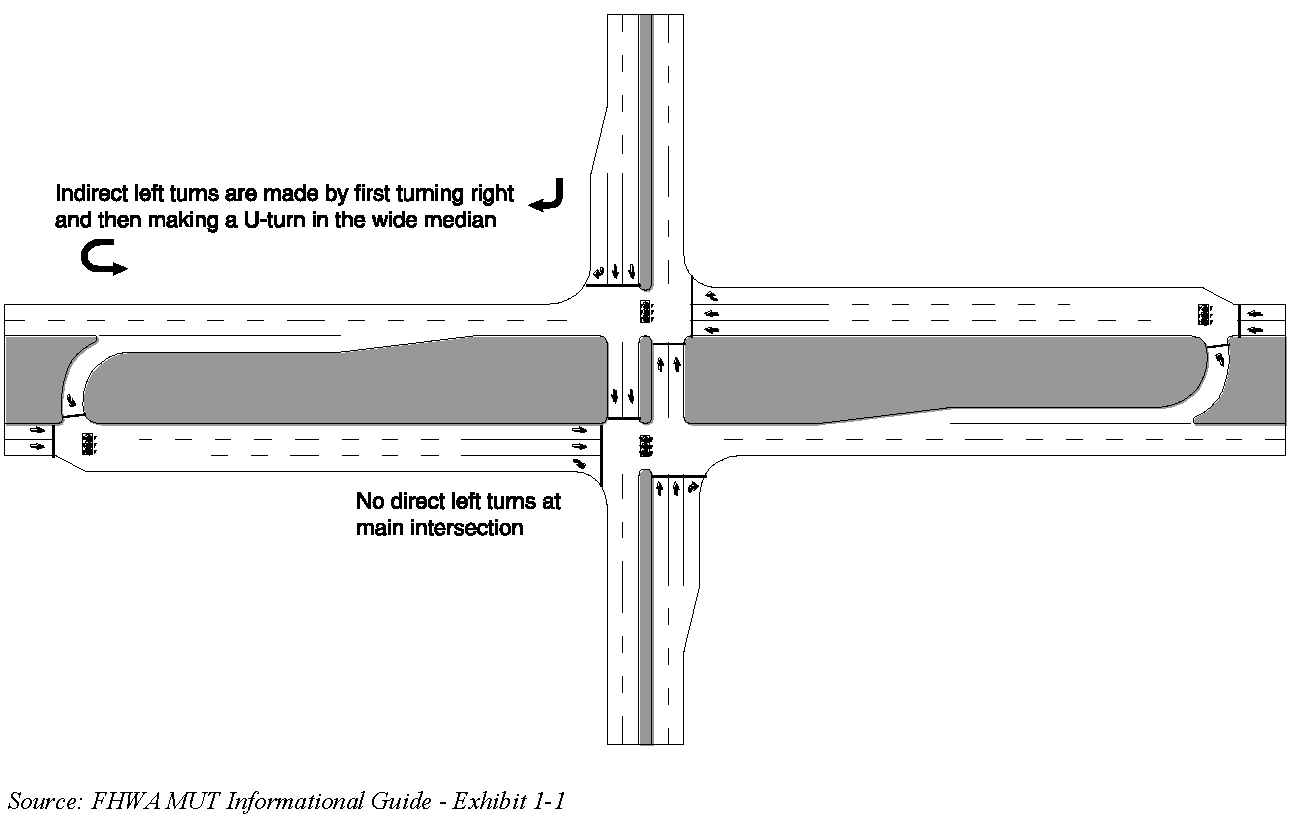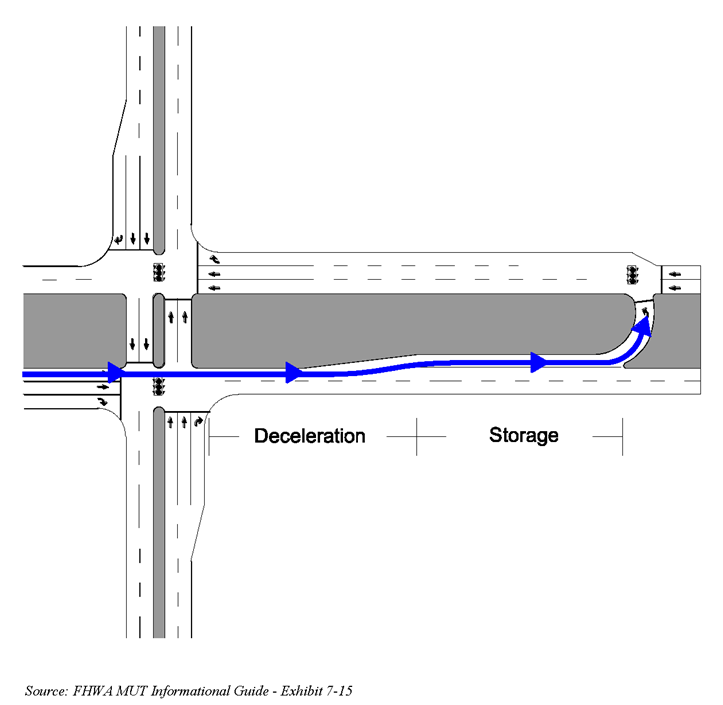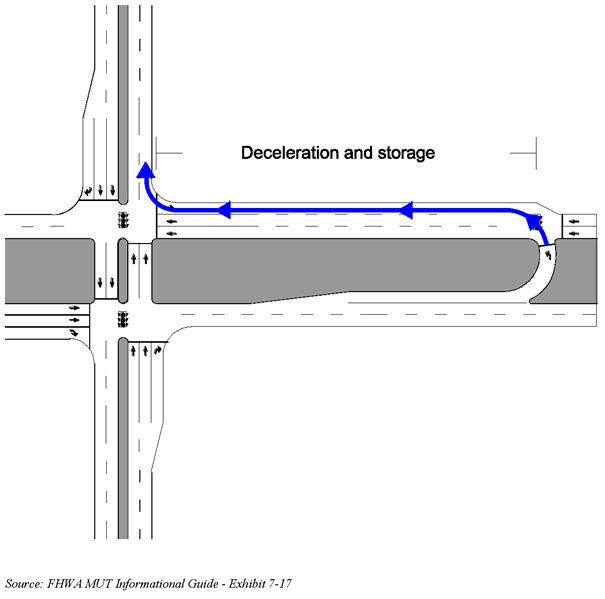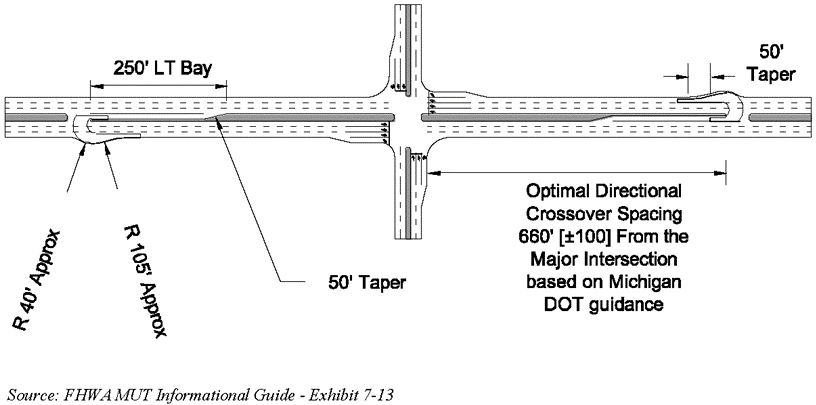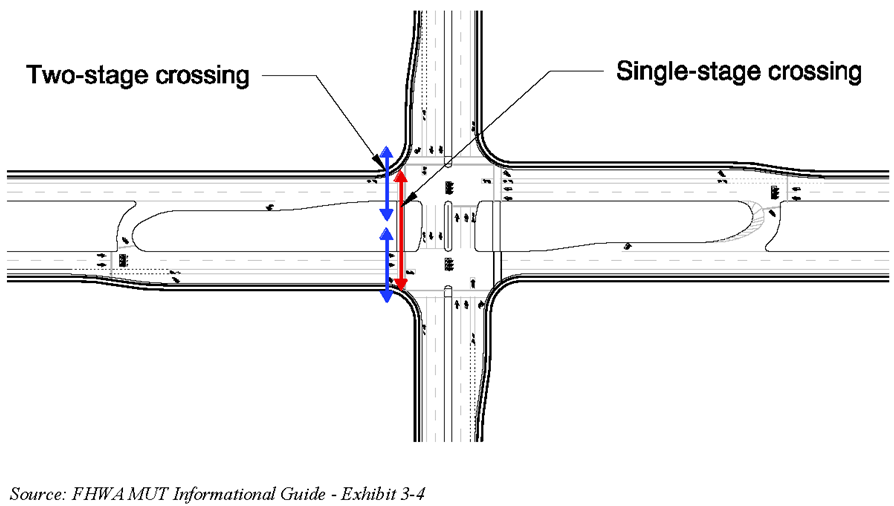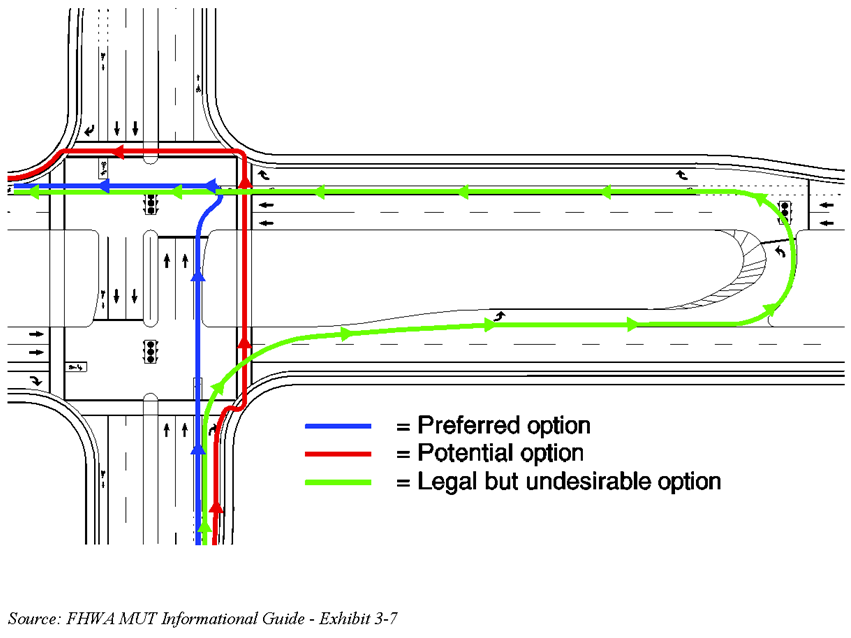Section 4: Median U-Turn Intersection (MUT)
Anchor: #i1005789Overview
The MUT is an intersection that replaces direct left turns at an intersection with indirect left turns using a U-turn movement in a wide median. The MUT intersection eliminates left turns on both intersecting streets, thus reducing the number of traffic signal phases and conflict points at the main crossing intersection, which results in improved intersection operations and safety. TxDOT has adopted the FHWA Median U-Turn Informational Guide as the primary source for MUT Guidelines. The information contained in this Appendix is considered a companion guide and is intended to document TxDOT’s suggested approach to MUT design. See Figure E-27 for an example MUT configuration.
Figure E-27. Example of a MUT Intersection With One Signal in Main Intersection
Some of the documented benefits of a MUT include:
- Anchor: #QTMVOWTG
- Removal of left-turn signal phasing which allows the intersection to operate well with a shorter cycle length. Anchor: #KJOCNPSA
- Reduction of intersection conflict points for both vehicles and pedestrians. Anchor: #MMHUVTFA
- General increase in safety performance.
Design Considerations
The distance between the MUT crossovers is central to the proper functioning of the intersection. The AASHTO recommended spacing from the main intersection to the median opening is 400 to 600-ft, although this distance may be modified per guidance in the FHWA Median U-Turn Informational Guide. Longer distances are preferred for weaving, but as the distance between the intersection and median opening increases, the delay for the minor road left-turn and through vehicles increases. See Figures E-28 through E-30 for spacing considerations.
Figure E-28. Spacing Consideration for a Major Street Left Turn Movement
Figure E-29. Spacing Consideration for Minor Street Left Turn Movement
Figure E-30. Spacing consideration for a Right Turn
The MUT median width is a function of the design vehicle (typically a WB-67 in Texas) and the preferred alignment of the design vehicle as it turns into the opposing traffic See Chapter 7 discussion on Median U-Turn Movements and minimum median width needed. For instances where the U-turn can't be completed, a loon may be used to provide additional space (see Figure E-31 as an example application for a longer weaving distance).
Figure E-31. Loon Design Serving a Design Vehicle
Anchor: #i1005886Location Considerations
Providing a stop controlled median U-turn location before the main intersection would improve land access between the main intersection and the crossover, route flow, and driver assumptions. However, U-turn movements may conflict with right turn movements. Figure E-32 shows an example of median U-turn locations. Designers must also ensure good intersection sight distances at MUT crossovers by making sure slopes and plantings in the median are cut back beyond the lines of sight.
Figure E-32. Stop Controlled Median U-Turn
Anchor: #i1005905Pedestrian and Bicyclist Considerations
MUTs have benefits for pedestrians which include a reduction in the number of conflict points and benefits due to two-phase signalization. Single and two-stage pedestrian crossings are shown in Figure E-33.
Figure E-33. Single Versus Two-Stage Pedestrian Crossings
Bicyclists have three options for navigating a MUT intersection when making a left turn:
- Anchor: #SUTFWWNJ
- Bicyclists making a two-stage left turn (preferred option): Minor street bicyclists approach the intersection on the right and follow the vehicle signal indications. When receiving the green indication, the bicyclists proceed across the intersection and stop in a bicycle turn queue box. When the major street receives a green indication, bicyclists proceed along the major street. Anchor: #GIUXRODK
- Bicyclists follow pedestrian crossing rules: Bicyclists approach the intersection and exit the street to the right and follow the pedestrian (“walk” /” don’t walk”) indications. Anchor: #UINKNAJL
- Bicyclists following vehicle rules: Bicyclists approach the intersection on the right and follow the vehicle signal indications. This option is legally permissible, but undesirable.
Ultimately, a thorough site assessment, an assessment of anticipated bicycle and pedestrian volumes, and an assessment of projected origins and destinations for pedestrians and bicyclists should be conducted to determine the preferred method of movement through the MUT.
Figure E-34 shows the three bicyclist options:
Figure E-34. Left Turn Options for Bicycles
Anchor: #i1005963Access Management
From an access management standpoint, possible advantages of a MUT include the elimination of left turns from driveways, and the consolidation of access to U-turn crossover intersections. Possible disadvantages include having to pass twice through intersections, and restricted access between main crossing and U-turn intersections. Reference the FHWA Alternative Intersections/Interchanges Informational Report (AIIR) for additional guidance with respect to access management.
